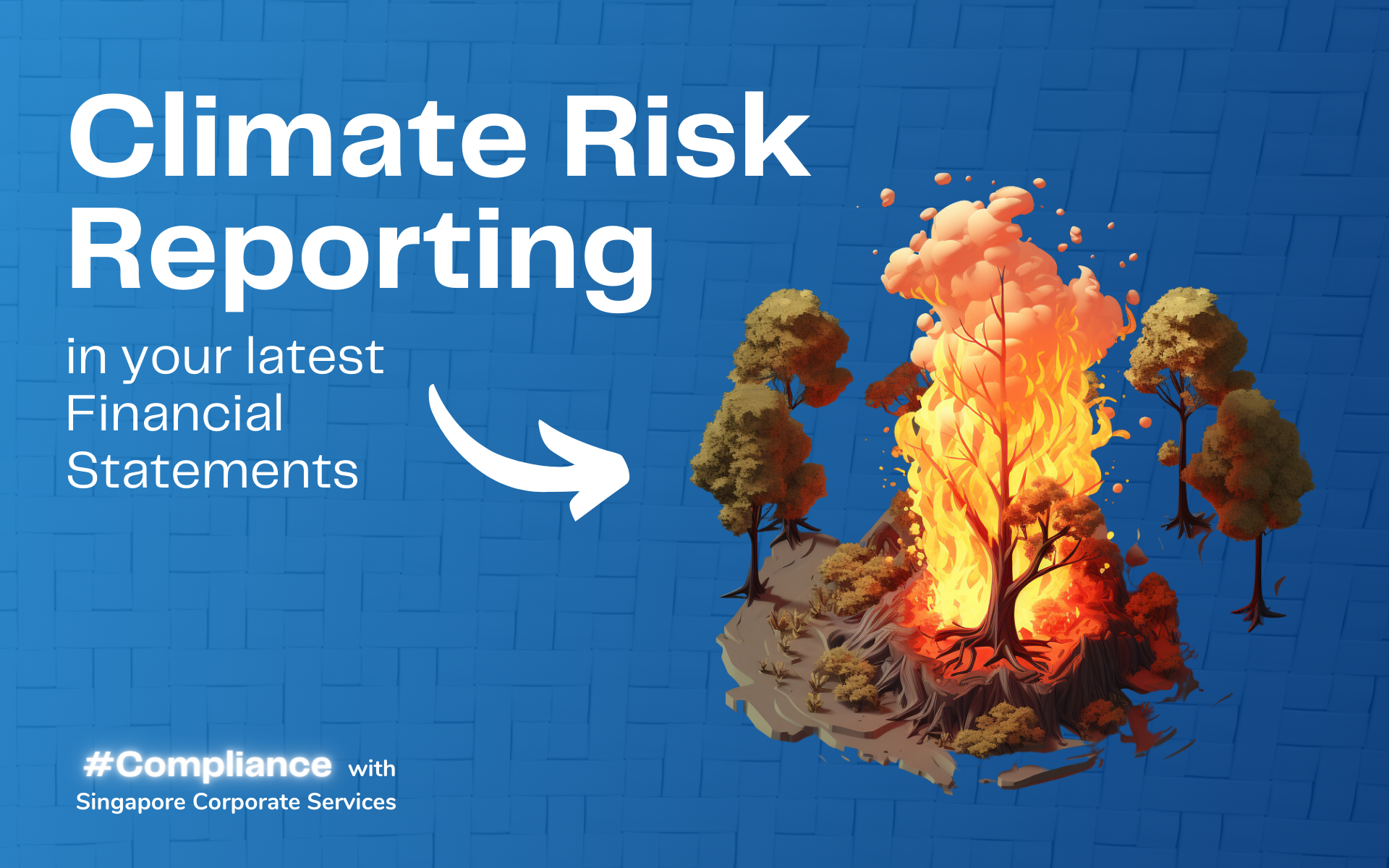Amidst climate change and increased investor demands for transparency, businesses must effectively report climate risks to avoid severe consequences such as reputation damage, legal liabilities, and reduced investor trust. A 2020 report by the Global Reporting Initiative (GRI) found that 83% of the world’s top 250 companies report their greenhouse gas (GHG) emissions, highlighting the growing importance of climate risk disclosure.
While there is already growing recognition of the importance of climate risk disclosure, there is a clear need for more comprehensive reporting and proactive measures to address climate-related challenges. This necessitates direct integration of climate-related risks and opportunities into your company’s financial statements, reflecting the increasing significance of climate change issues and the call for transparency.
The Need for Enhanced Transparency in Financial Reporting
As a company registered in Singapore, you are expected to provide insights into how climate-related factors might influence your financial performance, strategic direction, and risk management. This practice aligns with recommendations from the Task Force on Climate-related Financial Disclosures (TCFD), aimed at offering investors and stakeholders a transparent view of your company’s climate risks and opportunities.
Proactive adoption of transparent climate risk reporting is encouraged, even before it becomes mandatory due to regulatory changes. This step is crucial for well-informed decision-making, effective risk management, and aligning your operations with evolving ethical and humanitarian standards. The Singapore Accounting Standards Council (ASC) has established specific requirements for climate risk disclosure, guided by the TCFD recommendations. These requirements will be mandatory for listed companies by 2025 and unlisted companies by 2027.
The ASC’s guidance defines climate-related risks as potential adverse effects of climate change on your business, strategy, or financial performance, whether direct or indirect, and whether immediate or long-term. These risks can be categorised into two main types: physical risks, stemming from climate change-related events impacting your assets and operations, and transition risks, resulting from the move towards a low-carbon economy, including shifts in government policy and technological advancements.
Costs of Inadequate Climate Risk Disclosure for Your Business
On the other hand, inadequate climate risk disclosure can lead to detrimental consequences for your business, including higher capital and insurance costs, damage to your reputation, and fines or penalties for non-compliance. It can also lead to more widespread repercussions, such as uninformed investment decisions, market instability, and financial crises.
- Increased financial risk: Businesses that fail to adequately disclose their climate-related risks may face higher costs of capital and insurance.
- Reputational risk: Businesses that are seen to be greenwashing or not taking climate change seriously may face reputational damage, which could lead to lost customers and suppliers.
- Regulatory risk: Businesses that fail to comply with climate change disclosure requirements may face fines and other penalties.
Moreover, inadequate climate risk disclosure can have negative consequences for the Singapore financial system as a whole. For example, if investors are not aware of the climate-related risks faced by businesses, they may make misinformed investment decisions. This could lead to market instability and financial crises.
The Keppel Corporation Case
In 2021, Keppel Corporation was fined SGD50,000 by the Monetary Authority of Singapore (MAS) for failing to disclose its climate-related risks to investors in its 2019 annual report. The MAS found that Keppel Corporation had not disclosed information on its climate-related risks, such as the impact of climate change on its businesses and the steps it was taking to mitigate those risks.
In addition to the MAS’s enforcement action, Keppel Corporation has also faced reputational damage as a result of its failure to disclose its climate-related risks. The company has been accused of greenwashing and of not taking climate change seriously. This led to lost customers and investors.
Singapore Accounting Standards and Climate Risk Reporting
To state climate risk information into your financial statements, you have multiple avenues, such as notes to the accounts, management discussion and analysis, corporate governance reports, and quantitative financial data. This approach aligns with the TCFD’s recommendations, which encourage disclosing essential details about governance, strategy, risk management, metrics, and targets. By doing so, you provide a comprehensive overview of how your company addresses climate-related risks and opportunities.
Acknowledging the urgency of climate risk reporting, the Singapore Financial Reporting Standards (SFRS) have released guidance on how businesses should disclose climate-related risks and opportunities in their financial statements. This underscores the importance of integrating climate considerations into financial reporting practices.
Inclusion of climate risk information in financial statements
Climate risk information can be included in financial statements in a variety of ways. For example, you can disclose climate-related risks and opportunities in the notes to the accounts, the management discussion and analysis, and the corporate governance report.
You can also disclose climate-related risks and opportunities in your quantitative financial information. For example, you can disclose the impact of climate change on their assets and liabilities, and the steps they are taking to mitigate climate change risks. The TCFD recommends that companies disclose the following information in their financial statements:
Governance: How the company’s board of directors and management oversee the company’s climate-related risks and opportunities.
Strategy: How the company’s climate-related risks and opportunities affect the company’s strategy and business model.
Risk management: How the company identifies, assesses, and manages its climate-related risks.
Metrics and targets: How the company measures and manages its climate-related performance.
You can disclose this information in a variety of ways in your financial statements, including:
Notes to the accounts: The notes to the accounts are a good place to disclose detailed information about the company’s climate-related risks and opportunities.
Management discussion and analysis (MD&A): The MD&A is a good place to discuss the company’s climate-related risks and opportunities in relation to the company’s overall strategy and performance.
Corporate governance report: The corporate governance report is a good place to disclose information about the company’s governance of climate-related risks and opportunities.
Quantitative financial information: Companies can also disclose climate-related information in their quantitative financial information. For example, companies can disclose the impact of climate change on their assets and liabilities, and the steps they are taking to mitigate climate change risks.
You need to evaluate their climate risk exposure accurately in order to report it accurately to investors and other stakeholders. You can also use climate risk assessment tools to assess the transition risks posed by climate change, such as the risk of changes in government policy or technological change. This information will help investors and other stakeholders to make informed decisions about businesses.
Strategic Decision-Making in a Changing Climate Landscape
Climate risk reporting and management play a vital role in preparing Singapore businesses for the challenges of the changing climate landscape. Here are some examples of climate-related strategic decisions that businesses in Singapore are making:
- Investing in renewable energy and energy efficiency measures to reduce greenhouse gas emissions.
- Developing new products and services that help customers to adapt to the effects of climate change, such as flood-resistant buildings and climate-resilient crops.
- Relocating operations to areas that are less vulnerable to the effects of climate change.
- Discontinuing products and services that are high-carbon or that contribute to climate change.
Get help from the experts!
In essence, your business must adapt to the growing importance of climate risk reporting and embrace transparency to navigate the challenges and opportunities presented by climate change effectively. At Singapore Corporate Services (SCS), we specialise in simplifying the intricate world of climate risk reporting for businesses. Reach out to us today.
How to Change Your Company Name in Singapore
A company's name can significantly shape its identity, yet there are times when a change becomes...
Is Singapore a Tax Haven? A Comprehensive Analysis
Is Singapore really a tax haven, or is it simply capitalising on tax policies that spur economic...
Fiscal Year vs Financial Year: Definitions and Implications
Is there a difference between a fiscal year and a financial year? While they both refer to the...




